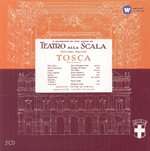|
Back
11/05/2014
Giacomo Puccini: Tosca
Maria Callas (Floria Tosca), Giuseppe Di Stefano (Mario Cavaradossi), Tito Gobbi (Scarpia), Franco Calabrese (Cesare Angelotti), Angelo Mercuriali (Spoletta), Melchiorre Luise (Il sagrestano), Dario Caselli (Sciarrone, Un carceriere), Alvara Cordova (Un pastore), Coro e Orchestra del Teatro alla Scala di Milano, Vittore Veneziani (chorus master), Victor de Sabata (conductor)
Recorded at Teatro alla Scala, Milan, Italy (August 10-21, 1953) – 109’
Warner Classics 0825646341030
2 Compact Discs with booklet essay in English, German, and French

   
I virtually wore the slipcase out. And thank goodness these were CDs and not LPs, otherwise they would’ve likely fallen victim as well. When I was coming of opera-listening age, the EMI “Callas Edition” was the latest incarnation of the legendary soprano’s complete opera and recital recordings. If Callas was the greatest Tosca on record, then this first studio recording of the role was logically the first choice among many collectors, and for a teenager like me, it was an immersive entry into opera's most potent melodrama.
Now, some 60 years after it was recorded, Warner Classics have remastered and reissued Maria Callas’ studio recordings in an astounding 70 disc box set. They have also released several albums, this Tosca included, individually alongside it. This is a mouthwatering release in that the remaster process at Abbey Road has gone back to the original master tapes to release these CDs as faithfully to the original recordings as possible. In the case of this Tosca the result is often spine-tingling.
The listener is immediately struck by how limited the recording technology of the early 1950s was when the famous “Scarpia” chords are blared out by the La Scala forces. In fact, it is almost jarring how constricted the mono sound of the orchestra is. To their credit, the engineers have enhanced the punch of the low bass in the orchestra (witness the pizzicati of the double basses in the second act) as well as the crispness in the high trebles, but the strings can sound bland and this is likely as good as it gets with this source material. Sabata's leadership is straightforward, concise, leaving much of the drama to the singers, but drawing some beautifully vulnerable sounds. And while the Milanese play with a sweeping fervor, no one ever bought this because of the orchestral playing.
No, Callas is the star, and here’s the good news: La Divina has scarcely sounded so real. The richness of her voice is breathtaking and the detail in her characterization leaps out of the speakers. The steely sheen of her voice is piercing, sounding much more nuanced than shrill. One almost can hear how well that legendary voice must have carried in the house. It is remarkable to hear the relative evenness of her entire range: high notes with a moderate, consistent vibrato, and a well-blended chest voice. And while the highs are as thrilling as ever, the breadth of Callas’ mid-voice is revelatory, which she uses with such power in the characterization of the fiery diva. Whether being coy with Cavaradossi in the first act duet or abjectly vulnerable in the middle of “Vissi d’arte,” the range of color and oration-like delivery in her lower-middle voice is where Callas’ magnetism as an actress set her apart. It is a strong and sexy sound that has never been equaled in opera.
Callas’ costars fair similarly in the remastering. Tosca’s lover, Cavaradossi, sung by Callas’ companion and recording partner, Giuseppe Di Stefano, is ardent and youthful. Di Stefano’s bright, Italianate sound is captured here in all its splendor. It is a voice that I struggle with appreciating, particularly as the tenor reaches the top of his register, but the heroic power he brings to the role is beyond reproach. It is a brash, confidant sound. Di Stefano’s “Vittoria!” is thrilling and his “E lucevan le stelle” is wistfully intimate, beautifully sung and captured.
Tito Gobbi’s Scarpia is nearly as definitive as his Greek counterpart’s diva is. And what makes it so sinister is the casual coolness with which Gobbi sang it. Gobbi delivered Puccini’s lines with little caricature, instead relying on his wooly baritone to deliver the malicious lines. They drip with a calculating corruption here. It is a bewitching performance that, like those of Di Stefano and Callas, sounds so immediate in this remaster.
From the first notes of Franco Calabrese as Angelotti, it is apparent how closely miked the singers were in this recording, in front of the orchestra, and it is a quality that is faithfully restored here, for better or for worse. This can make it sound as if there are two planes of sound, the singers, and the orchestra, but one of the more impressive executions is the second act offstage singing of Tosca and chorus. The layering of the forces results in a vivid, if still limited, aural perspective.
There is very little hiss, but just enough natural air to give the sound some headroom. I went back to my well-worn reissue from over 15 years ago and after listening to this newest one, it sounds more homogeneous. The vitality of the voices is missing while the planes of sound are much more unified. And while the dynamic range of this recording is naturally narrow given the limitations, the musicality of the sound is redeeming. The voices are presented so pristinely here. The beautiful echo at the climax of the third act duet “O dolci mani,” is an exquisite detail of many that makes this recording so vivid.
While the packaging restores the vintage artwork, there isn’t much else: a brief essay by Ira Siff and paper sleeves that, like my old black slipcase Callas Edition, are likely to wear away. The draw of Callas is timeless and, thanks to these remasters, is more irresistible than ever.
Matthew Richard Martinez
|